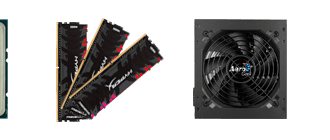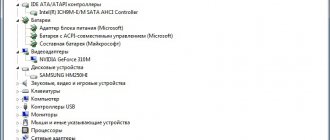Windows 7 is the version of the operating system that has the best reputation among users, because even after the release of Windows 10, Windows 7 continues to be used. And the reason lies in its high performance and launch speed, a minimal amount of additional software and a clear interface. However, it is not for nothing that there is an expression “Even an old woman has a problem,” which is relevant here, because the performance of Windows 7 can also drop to extremely low values, and there are enough reasons for this.
Diagnostics
But before moving on to the reasons, you should try to solve the problem with basic diagnostics. This means disabling certain components and starting the computer without them.
Windows 7 is the second most popular OS version
First, you need to disconnect all controllers, USB ports, audio devices, video devices, input devices, etc. If a positive result appears, then you need to connect them one by one to determine which device is the problem.
If Windows 7 still takes a long time to load, then you need to turn off the computer, disassemble the system unit, check all the cables, reconnect them, then remove the RAM, start it without it, insert it back and start the PC again.
This is a basic diagnosis, if it is ineffective, you need to read the article further.
Note! Don’t be alarmed when, after removing the RAM stick, a black screen appears.
Not enough free space on your hard drive
Why does Windows 10 take so long to load?
Quite often, a Windows 7 computer takes a long time to turn on because there is not enough free space on the drive. It is necessary to leave at least 20% for the operating system to function correctly. To free up space on the disk with the OC you should:
- Empty trash.
- Remove unnecessary shortcuts from the desktop.
- Useless files, such as programs or temporary files, should also be uninstalled.
- Clean Explorer - “My Documents” folder.
- Download special utilities designed to free up space on an HDD or SSD drive, for example, Ccleaner or Auslogics Boostspeed.
Important! Priority should be given to the system disk, that is, clean it first.
Programs in startup and operating system services
What to do if Yandex Browser takes a long time to load on Windows 7, 10
Also, if Windows 7 takes a long time to load, the reason for this may be a large number of programs in startup. Startup - a list of programs that start along with the operating system. Often this problem has a significant negative effect, and eliminating it will give the most visible result. To reduce the number of programs launched along with the operating system, you must:
- Press the key combination “Win + R”.
- In the window that appears, write “msconfig”.
- Next, select the “Startup” column.
- Uncheck unnecessary programs (all except antivirus and important software, for example, Realtek Manager) by hovering over them and clicking on “Apply”.
- To restart a computer.
Important! Using similar instructions, you can disable operating system services, only you need to open the “Services” column and not “Startup”. For beginners, it is better not to disable operating system services, especially from Microsoft.
The Startup section gets very full over time
Cleaning “Startup” with built-in tools
When choosing whether to remove an application from automatic download or leave it, you need to know for sure what it is intended for. Do not touch antiviruses, device drivers, system applications, update modules, or regularly used programs, such as email or communications. You can safely remove applications that were previously added by the user, as well as application programs, for example, file managers. There are several ways to find the list of automatically downloaded applications.
Via the Start menu
Press the “Start” on-screen button, select the “All programs” option located above it, and then find the “Startup” item in the drop-down list. By right-clicking on it, select “Open a common menu for all” in the list that appears.
In the Startup folder, select “Open a common menu for all”
The window that opens contains shortcuts to automatically downloaded applications. We remove the unnecessary ones, do not touch the necessary ones and do not touch the unknown ones.
Removing unnecessary shortcuts
By removing shortcuts from the Startup list, we do not touch the applications themselves. They remain on the computer, but will now be launched at the user’s command.
After a reboot, the changes will take effect.
Using "System Configuration" (msconfig command)
You can access System Configuration using the command line. First, call the “Run” window by simultaneously pressing the Win keys (with the Windows flag) and R. In the input line (to the right of “Open”), type the msconfig command and press the “OK” on-screen button.
Enter the command and click OK
If everything is done correctly, the “System Configuration” window will appear, in which we open the “Startup” tab.
We remove tags from unnecessary applications
To ensure that an unnecessary application no longer takes up memory when the system starts, you need to remove the checkbox next to its name. After making all the changes, just click “Apply” and “OK”. After rebooting, there will be no deleted applications in memory.
Through the registry editor (regedit command)
You can also remove unnecessary programs using the registry editor, which is called by the regedit command in the Run window.
Calling the registry editor
Sequentially moving through the directory tree on the left side of the window, we open the sections:
- HKEY_CURRENT_USER\ Software\ Microsoft\ Windows\ CurrentVersion\ Run
- HKEY_CURRENT_USER\ Software\ Microsoft\ Windows\ CurrentVersion\ RunOnce
They store links to applications launched by the current user.
Removing unnecessary programs
- HKEY_LOCAL_MACHINE\ SOFTWARE\ Microsoft\ Windows\ CurrentVersion\ Run
- HKEY_LOCAL_MACHINE\ SOFTWARE\ Microsoft\ Windows\ CurrentVersion\ RunOnce
They contain the same information common to all users of a given computer.
Now we act according to the already known algorithm: we delete familiar unnecessary shortcuts, we do not touch useful and unknown ones.
Antivirus software
What to do if Windows 10 won't boot
Also, Windows 7 can take a long time to start up because there are a lot of viruses on the computer. To check your PC for viruses, you need to download an antivirus, for example, 360 Total Security, and start scanning. When viruses are detected, the antivirus neutralizes them.
Note! You should not download several antivirus software at once, this will only load your computer even more. One good program is better than several bad ones. It is also better to refuse those programs that the browser offers, for example, “Cleaner”.
Updating the operating system to a new version
It helps to restore or update the operating system to a different version, for example, Windows 7 Home, or install a new build. Reinstallation is carried out using a flash drive or disk with the downloaded software.
Sometimes the result is a restore point. The system should be restored using the following algorithm:
- Open the Start menu, type “cmd” in the search and run as administrator.
- In the command line, type “rstrui.exe”.
- A list of restore points will appear, where you select the appropriate one and roll back the system.
Non-system problems
If a computer with the Windows 7 operating system takes a long time to start up, then the reason may not be in the OS. For example, erroneous BIOS settings, fragmentation, poorly readable hard drive sectors, or other non-system problems can greatly reduce performance. In such cases, you should diagnose the computer and then fix the problem.
Hard drive and SSD drive
A problematic drive is also a common occurrence, due to which Windows 7 takes a long time to load when you turn on the computer. There are 3 types of main file storage media on a computer:
- HDD;
- SSD;
- M2.
But this article will talk about the first two.
Mostly computer users use an HDD because it costs money and has a large capacity. But even a large volume does not exclude a lack of free space and, even more so, disk fragmentation.
For your information! Disk fragmentation is the division of a file into logical parts. The more fragmented files, the lower the computer's performance, because it is more difficult for the hard drive to search for files, since they are scattered throughout the drive.
The problem can be solved using the built-in software of Windows 7. To do this:
- You should go to the Start menu. Next, type “disk defragmentation” in the search and select the appropriate program.
- The program will have a column “Current state”, where you should select the disk to defragment.
- To determine whether a disk needs error correction, you need to analyze it.
- After the analysis, you should find out the percentage of defragmentation by going to the “Last run” tab.
- If the percentage is above 10, then defragmentation should be performed. To do this, click on the “Disk Defragmentation” item. At the request of the OS, enter the password for the administrator account.
If the disk is being used by any program or is formatted in a system other than NTFS, FAT or FAT32, then defragmentation will not be possible. Also, if the system does not see the disk in the “Current Status” column, you should first try to fix it.
Important! It is not possible to defragment network locations.
Bad sectors are also a problem in the hard drive. Basically, they occur if, for example, you turn off the computer, pull out the power plug, drop the hard drive, etc. You can eliminate them using special programs, for example, Victoria. However, if there are a lot of bad sectors on the hard drive, then it is better to immediately buy a new one.
Well, the last problem with an HDD drive is the long operation time. All components wear out, hard drives are no exception, so if it has been in the computer for more than 5 years, you need to go to the store for a new one. To check the disk status, use the CrystalDiscInfo program. If, after checking, she marked the hard drive with a yellow or red marker and reported a high temperature, the drive should be replaced.
HDD hard drive can easily fail
Now about solid state drives, that is, SSDs. It is recommended that every user purchase it, as with it the system will start up very quickly. However, it has disadvantages - a short service life and a high price. The first problem is no longer so relevant, but users are still afraid of it. You can avoid this by being careful and writing only important files to the SSD, and it is better to install games on the HDD, since solid-state drives have a limited number of rewrite cycles. You cannot defragment it, as this will only shorten its lifespan.
An SSD drive will significantly speed up your PC
BIOS
Problems with BIOS settings can be easily resolved - you just need to remove the battery and put it back in. Or find the “CMOS Reset” jumper on the motherboard, set it to the “On” position, and then back to “Off”.
Profiling with Windows Performance Toolkit
To optimize the system, including getting it started, you can use professional programs provided by Microsoft. The Windows Performance Toolkit, included in the Windows SDK, is designed to fine-tune (profil) system components, including Startup.
You can download the profiler on the company’s official website (https://www.microsoft.com/ru-RU/download/details.aspx?id=39982) by selecting the appropriate option.
We select only the package we need
The application generates detailed reports on the operation of loadable modules, software and hardware components of the system, and presents them in a convenient form. It is assumed that the program is used by an experienced user who understands the meaning of the detected parameters, the essence of the identified problems and ways to solve them.
By default, the package is unpacked into the created directory C:\Program Files\Microsoft Windows Performance Toolkit. To work, we use the command line, in which we type the file name (including the full path) of the executable module and the options for launching it. For example, to display help in the Run window, enter the command C:\Program Files\Microsoft Windows Performance Toolkit\xbootmgr –help
Each time you have to specify the full path
The command C:\Program Files\Microsoft Windows Performance Toolkit\xbootmgr -trace boot will immediately reboot the system (don't forget to save before starting!) and generate a report in the file boot_BASE+CSWITCH_1.etl, stored in the same directory.
In order to fully test the behavior of the operating system at startup, enter the same command with an additional parameter: C:\Program Files\Microsoft Windows Performance Toolkit\xbootmgr -trace boot–prepsystem. Now all that remains is to watch how the computer consistently reboots six times in a row.
After the team’s work is completed, our catalog will contain six reports with information on each reboot.
Hardware problems
When you turn on Windows 7, a long boot time can be caused by various problems in the hardware itself. For example, lack of RAM, dust, lack of storage space, poor cooling system.
Dustiness
So, if there is too much dust inside the case, then the cooling system draws in this dust, and the fan and radiator begin to clog, which leads to an inevitable deterioration in their performance, and this in turn has negative consequences: an increase in the temperature of the components, overloading the system. The computer is gradually starting to slow down.
Note! To avoid this, you need to regularly clean the system unit from dust, at least once every six months, and change the thermal paste on the processor.
RAM
Often there is only one problem with RAM - a critical lack of capacity. A modern computer requires at least 4 GB of RAM. To check the amount of RAM in your PC, you should:
- Go to the Start menu.
- Right-click on “This PC”.
The amount of RAM plays a significant role
You can find out the frequency and number of RAM sticks either through the BIOS (to open it, it is advisable to look at the instructions for your motherboard, but basically, when you turn on the computer, you just need to press “Delete”). There are also special programs for this, for example, Aida 64.
Important! If you know the exact amount of RAM in your computer, but the software shows a different figure, you should check the system unit from the inside. The contacts may have come loose or are not inserted correctly.
After the amount of RAM has become known, the system unit has been checked and it is clear that there is not enough volume, you should:
- Determine the motherboard model.
- Determine the type of RAM (DDR2, DDR3, etc.).
- Determine the RAM model.
- Determine the number of slots for RAM sticks in the motherboard (disassemble the system unit or find it on the Internet).
- Determine the frequency of RAM.
- Buy RAM of the same model or equivalent in characteristics, but with a larger capacity.
What does a RAM strip look like?
Poor cooling system
Many people know nothing about the cooling system, what it consists of and how it affects the computer. The cooling system in every computer is the minimum:
- CPU cooler;
- fans and heat pipes on the video card.
Be sure to clean radiators and fans from dust. If this does not help, then it is advisable to purchase additional fans to ventilate the case and replace the existing cooling system. This is done because Windows 7 may take a long time to start due to the high temperature of the components.
CPU cooler cools the insides of the PC
The computer takes a long time to boot when turned on: Solving the problem.
Many users are afraid of rebooting their computer.
This process should be easy and user-independent, but sometimes it can take a minute or two or seem like an eternity.
This is a rather controversial topic, since much of what is known about booting a computer is a myth.
But still, the operating system should not boot longer than 90 seconds. If the user is forced to endure more, it is worth starting to take action.
Windows loading slowly can be caused by a number of different reasons.
Computer diagnostics
Very often the user becomes nervous for no reason.
Diagnosis takes a lot of time. Although the reason may lie in the most common things.
Later in the review, you will learn various recommendations and tips that will help improve the overall boot speed of your PC.
It should be noted that these tips and tricks only apply to slow loading times in general. They will not work if the device itself is slow.
Tip: If you use your PC frequently, you can leave it on or set it to hibernate when you press the power button. In this case, there is no point in turning it off every time. Then the user gets rid of the need to deal with slow loading.
It's all about organizational skills and discipline. Take this example: very few software installations require regular reboots.
Some changes require a forced reboot while others simply “prompt” you to reboot now or later.
And let's be honest, sometimes users want to save time, which means they choose to reboot later... and sometimes that “later” happens much later.
And then several updates, patches and ignored reboot requests just pile on top of each other.
The system gets confused in the update order, and delays occur that are not visible to the eye of the average user.
After such a long-awaited reboot, the device takes some time to process all these changes. This is normal, but can still be annoying for most users.
Many do not even wait for this necessary download, and reboot the unfortunate device again. Then all updates are reset. This cannot be done.
Disable autostart programs
Programs that are loaded at startup remain active in memory.
Hence, they are one of the main reasons why Windows boots slowly. Disabling programs that the user is not using may work.
To manage startup programs, you can install a very interesting tool, Mike Lin's Startup Control Panel.
With its help, the user can easily remove unused programs from the list of resident programs and startup programs.
Scandisk and Defrag program
Using Microsoft Scandisk and disk defragmentation, you can make sure that your hard drive is working without errors.
These programs are also necessary to ensure that data is stored in the most efficient way.
Even experienced users run both of these programs at least once every few months.
Yes, they take some time to use. But it’s better to spend it once than to painfully wait for the download every time.
Not enough free space on your hard drive
Monitoring disk space
For a personal computer to perform optimally, it must have at least 250 MB of free hard disk space on which the operating system is installed.
If the amount of free space is less, overall performance and boot times may be significantly reduced.
The operating system itself takes up a lot of space, but in addition, additional space is used to temporarily store files needed during operation.
Determining free space on your hard drive.
In order to determine the availability of free space on your hard drive, you need to open “My Computer”.
In the window that opens there will be a column “Devices and disks”, then you need to right-click on Disk C. And select the “Properties” option from the drop-down menu.
The new screen will show the total volume, free volume and used space. It is necessary to check the data on Disk C, since the operating system is most often installed on it.
If there is not enough free space, you need to delete temporary files, clean the system of unused programs and recheck the free space.
Update Drivers and Windows
Custom, incorrectly installed, or outdated drivers can lead to a number of different conflicts.
It is necessary to regularly update operating system drivers, the Windows operating system itself, and also update the software used on the device.
This is the only way to guarantee that software problems will not arise.
All of the problems listed above are not yet related to hardware faults. This is a completely different layer of problems.
Updating the operating system to a new version
Still running Windows 7? Upgrading to Windows 8 or 10 will seriously speed up boot times.
Not every operating system update will necessarily be faster, but the jump from 7 to 8 was huge.
How to update the Windows operating system.
In order to obtain the necessary operating system updates, you need to go to the Control Panel.
Next, go step by step: Windows Update, check Windows updates.
If the necessary updates are found, the system will offer to automatically install the latest updates.
The user can only wait for the installed updates and reboot the device.
Cleaning the registry
Although many wizards recommend not using a registry cleaner often, in rare cases it can help improve the overall performance of Windows, including startup.
If the user has already followed all the previous recommendations from this list, but the long-awaited result has not yet arrived, you can clean the system registry. To do this, you can install any program from the Internet.
The process of cleaning the registry itself rarely depends on the user. Most programs work automatically.
Reinstalling Windows
Although this may require time and a free removable drive to save important files, it is one of the drastic solutions.
Additionally, the process itself can be a bit labor-intensive, requiring you to completely erase all data and reinstall Windows.
This process will result in the user's computer operating the same way it did when it was new.
Equipment modernization
This is a hardware method to solve the problem. There are more financial costs here than time and moral ones.
Of course, this is one of the most effective ways to increase performance and reduce loading times.
You just need to call any company that deals with modernization or upgrades and order the appropriate service from them.
You can also upgrade your computer yourself by replacing outdated components with new ones.
Adding RAM
Installing additional memory (RAM) for your computer helps increase the overall speed of the computer, and in some cases can reduce boot times by several times.
If your unit runs on less than two gigabytes of RAM, you should think about upgrading or expanding it.
Adding an SSD
A solid state drive is the most effective way to improve overall system performance.
On desktop and laptop computers, you can move Windows from a regular hard drive to an SSD. This will significantly reduce loading times.
Solid state drives are faster, more reliable, more resilient, and more stable. At the moment, this is the best choice among hard drives.
Resetting BIOS Settings
When you first set up your computer in BIOS Setup, the administrator may have disabled some settings.
In order to check what is disabled there, you need to press the del key for a long time when starting the computer.
This is the most common key that motherboard manufacturers assign to enter BIOS Setup.
If it doesn’t work, you should look on the Internet to find out how to enter BIOS Setup by selecting a specific motherboard model.
Once in the BIOS, you can enable the “fast boot option” mode and move the hard drive to the first place in the boot priority list. You also need to turn off "Logo" when loading.
Thus, the computer will not waste time displaying a beautiful picture, but will spend all its energy launching the operating system.
Disable unused hardware
When you first start any computer, it loads a lot of drivers, even though some of them are not used.
You need to go to Device Manager from the Start menu search bar.
There you need to find everything that is not used on the computer, for example, Bluetooth and third-party controllers, modems, virtual Wi-Fi adapters and other hardware that is not in the system. Right-click on the entry you want to disable and click “disable.”
Don't forget to double-check that all other peripheral devices are still working. If the computer is part of a wireless network, virtual Wi-Fi adapters should remain enabled.
Antivirus software
This is considered to be an obvious fact, but it is still worth noting separately.
To keep your computer running fast, you need to install a good antivirus program, keep it up to date, and run regular scans.
This is more of a preventive measure than a real solution to the problem of long loading times. But very often it is viruses that cause the computer to take a long time to boot.
Plus, any antivirus program will ensure that your files remain intact.
Unused fonts
Since time immemorial, loading additional fonts at startup has slowed down system boot times.
This is less of a problem now than it used to be, but can still be frustrating.
Windows 7 loads more than 200 fonts at startup; even more if you have Microsoft Office installed.
Chances are you use very few of these fonts, so you may want to hide them to speed up the process.
In Windows 7, you need to open the Fonts folder from the Start menu search bar and check for all the fonts that you don't need. Next, click the “hide” button on the toolbar.
This way, if you want them, you can get them back, but Windows doesn't load them at startup.
Please note that by simply removing a few fonts you will not see a noticeable difference.
For the results to be noticeable, you need to get rid of several hundred unused fonts.
There is more of a patience factor here; when you can mark more than a hundred fonts, everything will not seem so funny. And you will understand why they slow down the loading of your operating system so much.
Replacing the motherboard
This is one of the very drastic decisions, since it most often entails replacing the processor and RAM. But this will seriously reduce the computer boot time.
Sometimes the motherboard still works, but the hubs on it are already swollen. Which significantly reduces the speed of its operation. And only a specialized specialist can determine whether it can be repaired.
Again, these are not the only things you can do to reduce your computer's boot time, but they are some of the most well-known, reliable methods.
It is important to understand that by speeding up your computer's boot time, you want to achieve benefit, not harm.
Why does my computer take so long to boot?
The computer takes a long time to boot when turned on: Solving the problem
Equipment modernization
The long loading time of Windows 7 when turned on can be eliminated by replacing other components that were not mentioned in the article:
- motherboard;
- power unit;
- CPU.
Motherboard
Motherboard is the board on which all components are installed. There are generally few problems with it - swollen capacitors and wear.
To check the capacitors, you need to open the system unit and find cylindrical barrels on it. If swelling is detected, you should resolder them or take them to a technician.
The service life of the motherboard should not exceed 7-10 years, since then it is already considered obsolete and needs to be replaced.
Note! You can find out the motherboard model using the “msinfo32” command typed in a search engine (“Win + R”). In the window that opens, go to “System Information” and find the line “Model”.
The motherboard only lasts seven years
power unit
With the power supply, things are much more complicated than with other components. The reasons for computer malfunction may lie in:
- lack of power;
- swelling of capacitors;
- elevated temperature.
The power supply causes fewer problems
However, to fix problems with the power supply, you need to know the theory and have experience in practice. The best solution in this case is to contact a specialist.
CPU
If the operating system takes a long time to load, then the problem may be with the processor. Here are 2 reasons for this:
- Frequency reset. This is often due to elevated temperatures and overload. To avoid this, it is enough to change the cooling system;
- the processor is outdated. It’s the same here as with the motherboard: if the processor works for a long time, then it needs to be replaced.
The processor physically cannot work for too long
Note! Unfortunately, laptops require the support of a technician, as they require meticulous work and knowledge in this matter.
So, this article answered the question of why a Windows 7 computer takes a long time to boot when turned on, and described the main ways to solve this problem. If the PC still cannot turn on, then it is possible that it has been dropped many times; poorly assembled, because of this, the connection of wires and all operation are disrupted, for example, the motherboard may short out to the case; has used components, the history of which is unknown.
Antivirus
To eliminate the consequences of virus attacks, you should use an antivirus program. If you do not have it installed, select and download some, for example, a free utility from Microsoft - Security Essentials.
After completing the installation process, you need to run it and activate a full scan of the computer. Any viruses found will be removed, and Windows may take a long time to load and run slowly.











